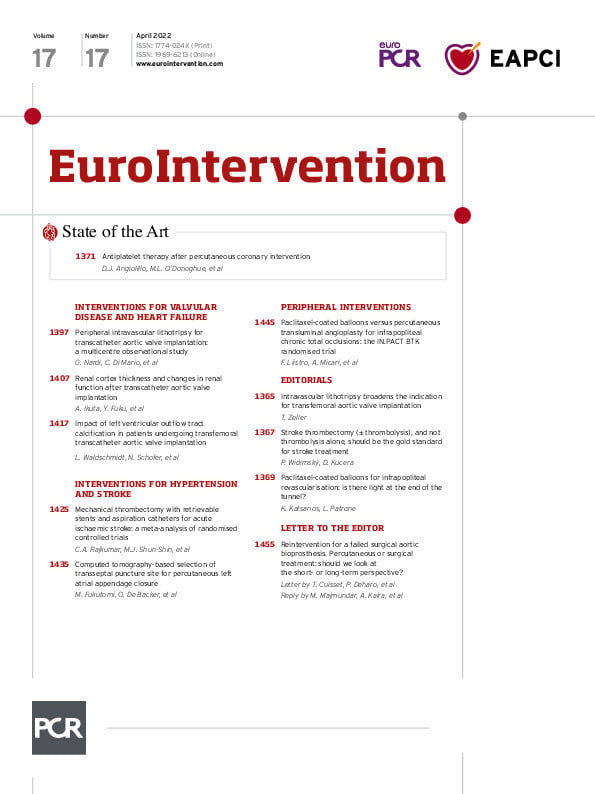Transfemoral aortic valve implantation (TAVI) is increasingly replacing classic open surgical valve replacement for the treatment of atherosclerotic aortic valve stenosis. However, in the elderly patient population, calcified common femoral and/or iliac artery stenosis may be present, and even if these lesions do not result in clinically relevant symptoms during walking, they may preclude transfemoral TAVI access1. Current catheter valve devices need large introducer sheath diameters of up to 22 Fr (corresponding to an outer diameter of 6.6 mm) and delivery system dimensions requiring an access vessel diameter, including for the common femoral and iliac arteries, of at least 6.5 to 7 mm. Notably, in small female patients, even a moderate calcified iliac artery lesion may limit the device passage. Vessel preparation with plain balloon angioplasty is limited by recoil and, in particular, in the external iliac artery, by the risk of dissection2. Stent implantation for access vessel preparation is limited by a potential risk of stent deformation when crossing the stented vessel segment with the introducer sheath, particularly in tortuous anatomies. Alternative access routes such as surgical access via the common iliac and transaxillary arteries are more invasive and associated with higher peri-interventional morbidity.
Recently, intravascular lithotripsy (IVL) has been shown to be effective in reducing recoil and dissection rates in calcified femoropopliteal lesions and in preparing the vessel for drug-coated balloon angioplasty34. So far, only anecdotal experience has been published for using IVL in iliac lesions due to limited balloon dimensions, even though an 8 mm IVL balloon diameter was recently put on the market.
In this issue of EuroIntervention, the multicentre registry of Nardi et al5 prospectively investigates the feasibility and safety of IVL for vessel preparation before inserting the TAVI delivery device, in the largest study population to date. The mean lesion diameter stenosis was only moderate (50.0±10.7%), with almost circumferential calcification in most cases. Following vessel preparation with IVL, transfemoral valve delivery was successful in all cases with an acceptable complication rate of 3.7%, including one perforation and seven dissections. All events were solved with either bare metal or covered stents. Most dissections occurred when the IVL target lesion was predilated with a regular balloon.
The present study suggests that if transfemoral TAVI is considered, even in patients without clinical signs of peripheral artery disease, proper CT-angiographic screening of the iliac and femoral access route for the presence of calcified stenosis and even mild stenotic concentric calcifications, in particular in tortuous anatomies, is highly recommended. Active and former smokers are at increased risk for developing diffuse aorto-iliac plaques. In small access arteries, such as the external iliac artery which is more vulnerable to creating dissections during balloon angioplasty, direct IVL should be performed without predilatation with a regular balloon. The present study has shown that predilatation prior to IVL results in a higher dissection rate.
Vessel preparation with IVL can be performed via crossover access from the contralateral side prior to inserting the valve delivery system, particularly if the common femoral and distal external arteries are stenotic. If an IVL balloon is not available in the reference vessel diameter dimension, a smaller sized IVL balloon can be used, followed by post-dilatation with an appropriately sized, regular, non-compliant balloon, provided the undersized IVL balloon is wall-adherent. Otherwise, the acoustic shockwaves will not be effectively delivered to the plaque. If, despite vessel preparation with IVL, a dissection should occur, stent placement prior to valve delivery should be avoided because a freshly implanted stent is in danger of becoming damaged during device passage. The only exception is vessel perforation, where immediate stent graft implantation is lifesaving.
In summary, IVL offers the potential for treating fragile patients with transfemoral TAVI who were not considered as candidates for transapical or open aortic valve replacement therapy in the past. The Heart Team therefore should not only consist of a cardiologist and cardiac surgeon but also include a radiologist and a vascular specialist.
Conflict of interest statement
T. Zeller reports honoraria received from: Abbott Vascular, BIBA Medical, Biotronik, Boston Scientific Corp., Cook Medical, Efemoral, Gore & Associates, Medtronic, Philips-Spectranetics, Shockwave and Veryan. He consulted for: Boston Scientific Corp., CSI, Gore & Associates, Medtronic, Veryan, Philips-Intact Vascular, Shockwave, Bayer, Vesper Medical, VentureMed and AN; and received institutional grants for research, clinical trials, or drug studies from: Bard Peripheral Vascular, Veryan, Biotronik, Cook Medical, Gore & Associates, Medtronic, Philips, Terumo, TriReme, Shockwave, Med Alliance, Intact Vascular, B. Braun; CSI, Boston Scientific, University of Jena, Pluristem, Philips, PQ Bypass, Surmodics, Alative Solutions and Reflow Medical.
Supplementary data
To read the full content of this article, please download the PDF.

